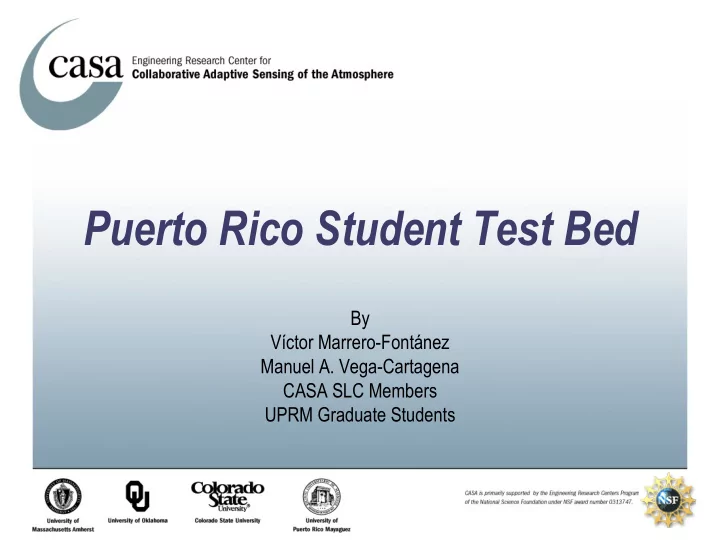

Puerto Rico Student Test Bed By Víctor Marrero-Fontánez Manuel A. Vega-Cartagena CASA SLC Members UPRM Graduate Students
Overview • What is CASA? – Student Test Bed (STB) • Magnetron Radar – Quantitative Precipitation Estimation (QPE) Study – Data Validation – Radar Specifications • Off-the-Grid Radar – Antenna
What is CASA? • Collaborative Adaptive Sensing of the Atmosphere • NSF Engineering Research Center Program – Established in 2003 • Objective – To create a new engineering paradigm in observing, detecting and predicting weather and other atmospheric phenomena. • Partner Universities – University of Massachusetts – Colorado State University – University of Oklahoma – University of Puerto Rico at Mayaguez
Student Test Bed • Objective – To establish a QPE sensing network starting in the western end of the island taking into consideration coverage gaps from NEXRAD. • Radar Sites – Three sites were selected based on geographical data and sociological impact. These are located in Mayagüez, Aguadilla and Lajas.
Student Test Bed
QPE Study • Quantitative Precipitation Estimation – One of main efforts of CASA – Studies using 2-D video disdrometer performed – QPE using attenuating wavelength • X-Band Radar
QPE Study • Path-Integrated Attenuation (PIA) – Study performed by Delrieu et al. [1] • Grenoble, France – Surface Reference Technique – Ratio of mountain returns • Presence and absence of rain – Later used for rain rate calculations • Rain rate retrieval algorithm not yet selected
QPE Study • Methodology – Low elevation angle – Identify mountain cluttered radar bins using apparent reflectivity • Calculate average Z a over cluttered bins during dry period • Compare to average Z a during rain event – Perform rain rate retrieval
Data Validation • Several Tipping-Bucket Rain Gauges – Located along propagation path • Joss Waldvogel Impact Disdrometer – Rain Drop Size Distribution (DSD) – Expected Reflectivity Calculations
Radar Specifications • Raytheon Marine X-Band Radar • Single Polarization – Magnetron • F = 9.41 GHz • P peak = 25 kW • Duty Cycle max = 0.001
Radar Specifications • Modifications – Antenna • 1.22m Parabolic Dish • G = 38 dB • 2.0˚ HPBeamwidth – Spinner • Originally 25 RPM • Lowered to 3 RPM
Radar Specifications • Modifications – Data System • Linux based Mini-ITX embedded system • 12 Bit ADC for sampling video signal • 802.11b data transport to data archive server – Control • FPGA on PCI bus for timing signals and antenna position encoder data
Radar Specifications • Location – Roof of electrical engineering building at UPRM – Tower already installed
Radar Specifications Raytheon X-Band Radar Modified Front End Diagram Antenna Magnetron Isolator Circulator Power Sampler M 50 dB IL = 0.5 dB 9.41 GHz IL = 0.4 dB Isolation = 25 dB P = 25 kW = 74 dBm HPBeamwidth = 2.0° 35 dB Gain = 38.0 dBi Attenuator Limiter Pmax = 26 dBm Load IL = 2 dB Raytheon HV Power Combiner Modulator PIN Switch (Reflective ) Board IL = 0.85dB Isolation ≥ 67 dB Noise Source ENR = 15.5 dB Gain = 7.0 dB LNA P1dB = -8 dBm Calibration Loop F = 3.5 dB IR Mixer VCO 9.470 GHz IF 60MHz Receiver Noise Figure = 8.00 dB To Data Receiver Dynamic Range = 91.74 dB System
OTG Antenna Single polarization 16 x 16 antenna array • Physical size: 17” by 17” • Material: TLY-3 from Taconic • Er = 2.2, h = 0.787mm • Resonant Frequency = 9.38GHz[*] • Antenna tested in RadLab. • The antenna did not perform as expected. [*] result given by Designer
OTG Antenna • BW of single-pol antenna: 9.25 - 9.6 GHz [VSWR < 2]. • Higher side-lobes in left side of the pattern due to undesired radiation in the corporate feed. [ measured in Radiation Lab.]
OTG Antenna • A multi-layer antenna is under design for dual polarization. • Both polarizations are fed by aperture coupling. • The array antenna will have rows of these patches connected in series. • Resonant Frequency: 9.5 GHz [*] • Cross-polarization: Around 29 dB for a single patch for each polarization is expected. Dual polarization patch antenna • This patch exhibits linear polarization and/or circular polarization if desired.
Latest Achievements • Radar antenna moved to Stefani building rooftop.
Questions
References [1] Delrieu, G. et al., “Rain Measurement in Hilly Terrain with X-Band Weather Radar Systems: Accuracy of Path-Integrated Attenuation Estimates Derived from Mountain Returns ”, Journal of Atmospheric and Oceanic Technology , Vol. 16, pp. 405-415, April 1999. [2] Rincón, R.F. et al. “Estimation of Path-Average Rain Drop Size Distribution using the NASA/TRMM Microwave Link”, IEEE International Geoscience and Remote Sensing Symposium (IGARSS), Vol. 3, 9-13 July, 2001.
Recommend
More recommend